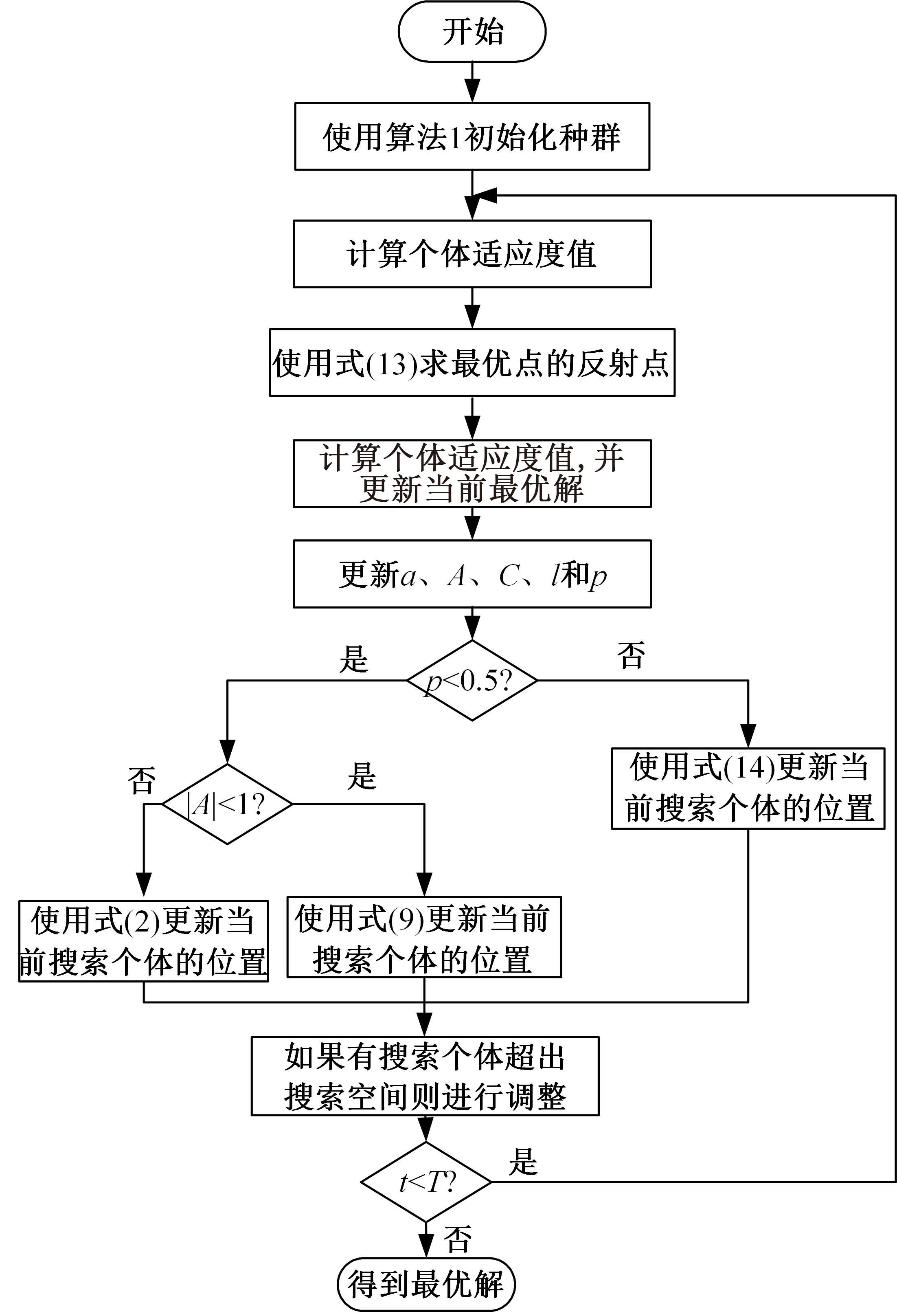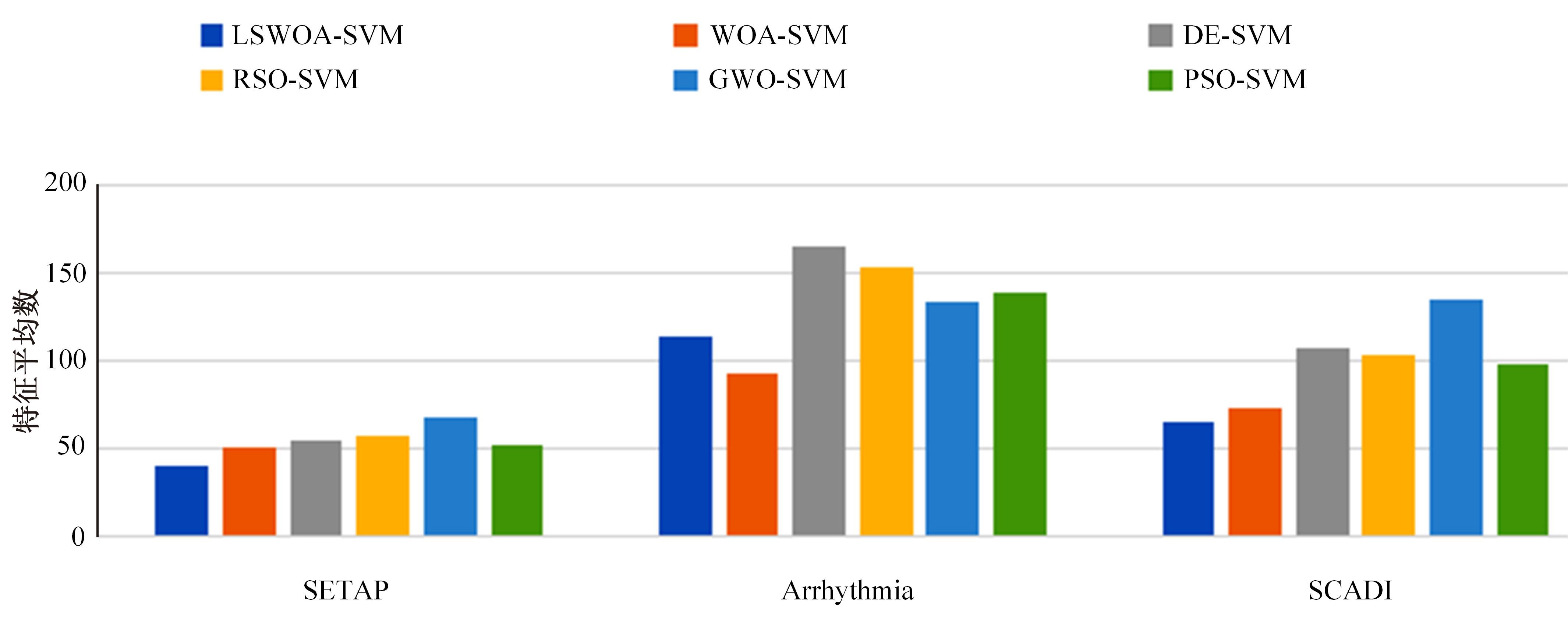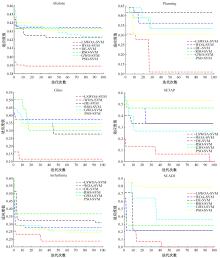Journal of Jilin University(Engineering and Technology Edition) ›› 2023, Vol. 53 ›› Issue (10): 2952-2963.doi: 10.13229/j.cnki.jdxbgxb.20211348
Previous Articles Next Articles
SVM parameters and feature selection optimization based on improved whale algorithm
Hui GUO1,2( ),Jie-di FU1,2,Zhen-dong LI1,2(
),Jie-di FU1,2,Zhen-dong LI1,2( ),Yan YAN3,Xiao LI1,2
),Yan YAN3,Xiao LI1,2
- 1.School of Information Engineering,Ningxia University,Yinchuan 750021,China
2.Collaborative Innovation Center for Ningxia Big Data and Artificial Intelligence Co-founded by Ningxia Municipality and Ministry of Education,Yinchuan 750021,China
3.Electric Power Research Institute,State Grid Ningxia Power Co. ,Ltd. ,Yinchuan 750011,China
CLC Number:
- TP301.6
| 1 | Meenakshi S. Improving the performance of heart disease classification using chaotic tent map based whale optimizer for feature selection with SVM algorithm[J]. Turkish Journal of Physiotherapy and Rehabilitation,2021, 32(3): 4229-4244. |
| 2 | Antal B, Hajdu A. An ensemble-based system for automatic screening of diabetic retinopathy[J]. Knowledge-based Systems, 2014, 60: 20-27. |
| 3 | Phuong T M, Lin Z, Altman R B. Choosing SNPs using feature selection[C]∥IEEE Computational Systems Bioinformatics Conference,Stanford, USA, 2005: 301-309. |
| 4 | Hamla H, Ghanem K. Comparative study of embedded feature selection methods on microarray data[C]∥IFIP International Conference on Artificial Intelligence Applications and Innovations, Hersonissos, Greece, 2021: 69-77. |
| 5 | Blum Christian, Roli Andrea. Metaheuristics in combi-natorial optimization: overview and conceptual comparison[J]. ACM Comput Surv, 2003, 35(3): 268-308. |
| 6 | Mirjalili S, Mirjalili S M, Lewis A. Grey wolf optimizer[J]. Advances in Engineering Software, 2014, 69: 46-61. |
| 7 | Kennedy J, Eberhart R. Particle swarm optimization[C]∥Proceedings of International Conference on Neural Networks, Perth, Australia, 1995: 1942-1948. |
| 8 | Wong K P, Dong Z Y. Differential evolution, an alternative approach to evolutionary algorithm[C]∥Proceedings of the 13th International Conference on, Intelligent Systems Application to Power Systems, Arlington, USA, 2005: 73-83. |
| 9 | Dhiman G, Kaur A. STOA: a bio-inspired based optimization algorithm for industrial engineering problems[J]. Engineering Applications of Artificial Intelligence, 2019, 82: 148-174. |
| 10 | Zhang Y, Gong D, Cheng J. Multi-objective particle swarm optimization approach for cost-based feature selection in classification[J]. IEEE/ACM Transactions on Computational Biology and Bioinformatics, 2015, 14(1): 64-75. |
| 11 | Sayed G I, Darwish A, Hassanien A E. A new chaotic whale optimization algorithm for features selection[J]. Journal of Classification, 2018, 35(2): 300-344. |
| 12 | 张文杰, 蒋烈辉. 一种基于遗传算法优化的大数据特征选择方法[J]. 计算机应用研究, 2020, 37(1): 50-52, 56. |
| Zhang Wen-jie, Jiang Lie-hui. A feature selection method for big data based on genetic algorithm optimization[J]. Computer Application Research, 2020, 37(1): 50-52, 56. | |
| 13 | Mirjalili S, Saremi S, Mirjalili S M, et al. Multi-objective grey wolf optimizer: a novel algorithm for multi-criterion optimization[J]. Expert Systems with Applications, 2016, 47: 106-119. |
| 14 | 贾鹤鸣, 李瑶, 孙康健. 基于遗传乌燕鸥算法的同步优化特征选择[J]. 自动化学报, 2022, 48(6): 1601-1615. |
| Jia He-ming, Li Yao, Sun Kang-jian. Synchronous optimization feature selection based on Genetic Black-tern algorithm[J]. Automatica, 2022, 48(6): 1601-1615. | |
| 15 | 沈永良, 宋杰, 万志超. 基于改进烟花算法的SVM特征选择和参数优化[J]. 微电子学与计算机, 2018, 35(1): 21-25. |
| Shen Yong-liang, Song Jie, Wan Zhi-chao. SVM feature selection and parameter optimization based on improved fireworks algorithm[J]. Microelectronics and Computers, 2018, 35(1): 21-25. | |
| 16 | 姚全珠, 蔡婕. 基于PSO的LS-SVM特征选择与参数优化算法[J]. 计算机工程与应用, 2010, 46(1): 134-136, 229. |
| Yao Quan-zhu, Cai Jie. LS-SVM Feature selection and parameter optimization algorithm based on PSO[J]. Computer Engineering and Applications, 2010, 46(1): 134-136, 229. | |
| 17 | Mirjalili S, Lewis A. The whale optimization algorithm[J]. Advances in Engineering Software, 2016, 95: 51-67. |
| 18 | Mafarja Majdi M, Seyedali Mirjalili. Hybrid whale optimization algorithm with simulated annealing for feature selection[J]. Neurocomputing, 2017, 260: 302-312. |
| 19 | Jadhav Amolkumar Narayan, Gomathi N. WGC: hybridzation of exponential grey wolf optimizer with whale optimization for data clustering[J]. Alexandria Engineering Journal, 2018, 57: 1569-1584. |
| 20 | Yan Z, Zhang J, Zeng J, et al. Nature-inspired approach: an enhanced whale optimization algorithm for global optimization[J]. Mathematics and Computers in Simulation, 2021, 185: 17-46. |
| 21 | 龙文, 蔡绍洪, 焦建军, 等. 求解大规模优化问题的改进鲸鱼优化算法[J]. 系统工程理论与实践, 2017, 37(11): 2983-2994. |
| Long Wen, Cai Shao-hong, Jiao Jian-jun, et al. Improved whale optimization algorithm for solving large scale optimization problems[J]. Systems Engineering Theory and Practice, 2017, 37(11): 2983-2994. | |
| 22 | Zhang Y, Zhang Y, Wang G, et al. An improved hybrid whale optimization algorithm based on differential evolution[C]∥International Conference on Artificial Intelligence and Electromechanical Automation (AIEA), Tianjin, China, 2020: 103-107. |
| 23 | 毕孝儒, 牟琦, 龚尚福. 融合动态概率阈值和自适应变异的鲸鱼优化算法[J]. 微电子学与计算机, 2019, 36(12): 78-83. |
| Bi Xiao-ru, Mou Qi, Gong Shang-fu. Whale optimization algorithm combining dynamic probability threshold and adaptive variation[J]. Microelectronics and Computers, 2019, 36(12): 78-83. | |
| 24 | Shi X, Li M. Whale optimization algorithm improved effectiveness analysis based on compound chaos optimization strategy and dynamic optimization parameters[C]∥International Conference on Virtual Reality and Intelligent Systems, Jishou, China, 2019: 338-341. |
| 25 | Mostafa Bozorgi S, Yazdani S. IWOA: an improved whale optimization algorithm for optimization problems[J]. Journal of Computational Design and Engineering, 2019, 6(3): 243-259. |
| 26 | Zamli K Z. Optimizing S-box generation based on the adaptive agent heroes and cowards algorithm[J]. Expert Systems with Applications, 2021,182: No.115305. |
| 27 | Nelder J A, Mead R. A simplex method for function minimization[J]. The Computer Journal, 1965, 7(4): 308-313. |
| 28 | 郭德龙, 周锦程, 周永权. 基于Levy飞行改进蝴蝶优化算法[J]. 数学的实践与认识, 2021, 51(12): 130-137. |
| Guo De-long, Zhou Jin-cheng, Zhou Yong-quan. Improved butterfly optimization algorithm based on Levy flight[J]. Practice and Understanding of Mathematics, 2021, 51(12): 130-137. | |
| 29 | Aljarah I, Al-Zoubi A M, Faris H, et al. Simultaneous feature selection and support vector machine optimization using the grasshopper optimization algorithm[J]. Cognitive Computation, 2018, 10(2): 478-495. |
| 30 | Dua D, Graff C. UCI machine learning repository[R]. Irvine: University of California, School of Information and Computer Science, 2019. |
| 31 | Blake C. UCI repository of machine learning databases[DB/OL].[2020-07-04]. . |
| [1] | Feng-feng ZHOU,Zhen-wei YAN. A model for identifying neuropeptides by feature selection based on hybrid features [J]. Journal of Jilin University(Engineering and Technology Edition), 2023, 53(11): 3238-3245. |
| [2] | Li-li BAI,Feng-guo JIANG,Yu-ming ZHOU,Xiao ZENG. Optimized design of structure reliability based on improved whale algorithm [J]. Journal of Jilin University(Engineering and Technology Edition), 2023, 53(11): 3160-3165. |
| [3] | Pei-ze LI,Shi-shun ZHAO,Xiao-hui WENG,Xin-mei JIANG,Hong-bo CUI,Jian-lei QIAO,Zhi-yong CHANG. A new method for rapid detection of pesticide residues based on multi⁃sensor optimization [J]. Journal of Jilin University(Engineering and Technology Edition), 2022, 52(8): 1951-1956. |
| [4] | Feng-feng ZHOU,Hai-yang ZHU. SEE: sense EEG⁃based emotion algorithm via three⁃step feature selection strategy [J]. Journal of Jilin University(Engineering and Technology Edition), 2022, 52(8): 1834-1841. |
| [5] | Bin WANG,Bing-hui HE,Na LIN,Wei WANG,Tian-yang LI. Tea plantation remote sensing extraction based on random forest feature selection [J]. Journal of Jilin University(Engineering and Technology Edition), 2022, 52(7): 1719-1732. |
| [6] | Sheng-sheng WANG,Lin-yan JIANG,Yong-bo YANG. Transfer learning of medical image segmentation based on optimal transport feature selection [J]. Journal of Jilin University(Engineering and Technology Edition), 2022, 52(7): 1626-1638. |
| [7] | Yin-di YAO,Jun-jin HE,Yang-li LI,Dang-yuan XIE,Ying LI. ET0 simulation of self⁃constructed improved whale optimized BP neural network [J]. Journal of Jilin University(Engineering and Technology Edition), 2021, 51(5): 1798-1807. |
| [8] | Jing-bin LI,Yu-kun YANG,Bao-qin WEN,Za KAN,Wen SUN,Shuo YANG. Method of extraction of navigation path of post-autumn residual film recovery based on stubble detection [J]. Journal of Jilin University(Engineering and Technology Edition), 2021, 51(4): 1528-1539. |
| [9] | Wan-fu GAO,Ping ZHANG,Liang HU. Nonlinear feature selection method based on dynamic change of selected features [J]. Journal of Jilin University(Engineering and Technology Edition), 2019, 49(4): 1293-1300. |
| [10] | ZHAO Dong,SUN Ming-yu,ZHU Jin-long,YU Fan-hua,LIU Guang-jie,CHEN Hui-ling. Improved moth-flame optimization method based on combination of particle swarm optimization and simplex method [J]. Journal of Jilin University(Engineering and Technology Edition), 2018, 48(6): 1867-1872. |
| [11] | KUI Hai-lin, BAO Cui-zhu, LI Hong-xue, LI Ming-da. Idling time prediction method based on least square support vector machine [J]. Journal of Jilin University(Engineering and Technology Edition), 2018, 48(5): 1360-1365. |
| [12] | LIU Jie, ZHANG Ping, GAO Wan-fu. Feature selection method based on conditional relevance [J]. 吉林大学学报(工学版), 2018, 48(3): 874-881. |
| [13] | GENG Qing-tian, YU Fan-hua, WANG Yu-ting, GAO Qi-kun. New algorithm for vehicle type detection based on feature fusion [J]. 吉林大学学报(工学版), 2018, 48(3): 929-935. |
| [14] | YUAN Zhe-ming, ZHANG Hong-yang, CHEN Yuan. HIV-1 protease cleavage site prediction based on feature selection and support vector machine [J]. 吉林大学学报(工学版), 2017, 47(2): 639-646. |
| [15] | LU Ying, WANG Hui-qin, QIN Li-ke. Accurate fire location method in high and large-span space buildings [J]. 吉林大学学报(工学版), 2016, 46(6): 2067-2073. |
|
||













